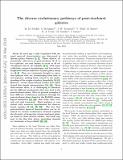The diverse evolutionary pathways of post-starburst galaxies
Abstract
About 35 years ago a class of galaxies with unusually strong Balmer absorption lines and weak emission lines was discovered in distant galaxy clusters1,2. These objects, alternatively referred to as post-starburst, E+A or k+a galaxies, are now known to occur in all environments and at all redshifts3,4,5,6,7, with many exhibiting compact morphologies and low-surface brightness features indicative of past galaxy mergers3,8. They are commonly thought to represent galaxies that are transitioning from blue to red sequence, making them critical to our understanding of the origins of galaxy bimodality9,10,11,12,13,14. However, recent observational studies have questioned this simple interpretation15,16,17,18. From observations alone, it is challenging to disentangle the different mechanisms that lead to the quenching of star formation in galaxies. Here we present examples of three different evolutionary pathways that lead to galaxies with strong Balmer absorption lines in the Evolution and Assembly of GaLaxies and their Environments (EAGLE) simulation19,20: classical blue → red quenching, blue → blue cycle and red → red rejuvenation. The first two are found in both post-starburst galaxies and galaxies with truncated star formation. Each pathway is consistent with scenarios hypothesized for observational samples2,15,18,21,22. The fact that ‘post-starburst’ signatures can be attained via various evolutionary channels explains the diversity of observed properties, and lends support to the idea that slower quenching channels are important at low redshift23,24.
Citation
Pawlik , M M , McAlpine , S , Trayford , J W , Wild , V , Bower , R , Crain , R A , Schaller , M & Schaye , J 2019 , ' The diverse evolutionary pathways of post-starburst galaxies ' , Nature Astronomy , vol. 3 , no. 5 , pp. 440-446 . https://doi.org/10.1038/s41550-019-0725-z
Publication
Nature Astronomy
Status
Peer reviewed
ISSN
2397-3366Type
Journal article
Description
Funding: M.M.P. and V.W. acknowledge support of the European Research Council (SEDMorph, principal investigator V.W.); supported by the Science and Technology Facilities Council (grant number ST/P000541/1).Collections
Items in the St Andrews Research Repository are protected by copyright, with all rights reserved, unless otherwise indicated.

